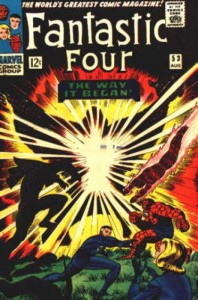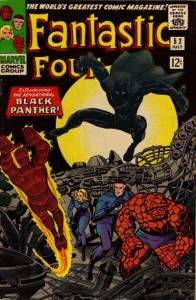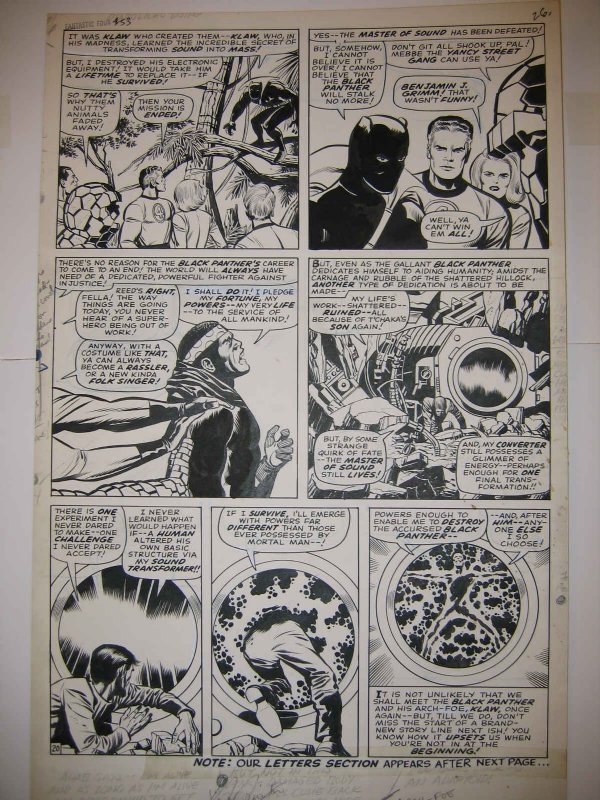Bermudian Collector: Black Panther Superhero
 Silvio Berlusconi, Michael Bloomberg and Ross Perot aren’t the only international political figures with part-time Bermuda addresses. Now Wakanda’s warrior-king has taken up residence in Bermuda. Almost half of the 20 pages of artwork from “Fantastic Four” # 53 — featuring the second appearance and origin story of the Black_Panther, Marvel Comics’ first black superhero — belong to a Bermudian collector.
Silvio Berlusconi, Michael Bloomberg and Ross Perot aren’t the only international political figures with part-time Bermuda addresses. Now Wakanda’s warrior-king has taken up residence in Bermuda. Almost half of the 20 pages of artwork from “Fantastic Four” # 53 — featuring the second appearance and origin story of the Black_Panther, Marvel Comics’ first black superhero — belong to a Bermudian collector.
Published in 1966, the 13.5-by-20 inch black and white pages (colour was added in the printing process) by penciller Jack Kirby with ink finishes by Joe Sinnott are among the most highly prized pop culture collectibles of their kind in the world and are estimated to be worth in the hundreds of thousands of dollars.
A thriving boutique market among collectors and speculators for original comic book art has emerged in recent years, with some individual pages from classic issues or by highly sought-after artists routinely fetching tens of thousands of dollars.
“It’s rare that the origin story of a key character from the Marvel Universe becomes available,” said the Bermudian collector, who asked not to be named for reasons of privacy. “Owning all of the pages would have been prohibitively expensive — for this very reason, the few genuinely significant complete 20-page Marvel Comics stories from this period which do turn up tend to be broken up and sold on a page-by-page basis.
“But I was lucky enough, over a period of several years, to acquire the most important pages, both artistically and historically.”
Created by Kirby and writer-editor Stan Lee, the Black Panther debuted in “Fantastic Four” #52 (1966), the first black superhero in mainstream comics. He remains a keystone character in the Marvel Universe, the king of the fictitious super-scientific African country of Wakanda, the husband of the X-Men’s Storm and a key member of the supergroup The Avengers.
The title “Black Panther” is a rank of office, king of the Wakandan Panther Clan. As chieftain, the Black Panther has as mystical connection with the Wakandan Panther god who grants him superhumanly acute senses and increases his strength, speed, stamina, and agility to the peak of human development.
“In the case of the Black Panther you’re dealing with an origin story that has a cultural significance which goes well beyond the rarefied confines of the comic art world,” said the Bermudian collector. “The character was both Marvel’s acknowledgement of the US Civil Rights movement and a salute to its African-American readers — Marvel had featured non-superpowered black supporting characters from its launch in the very early ’60s, a time when you rarely saw blacks on network television or in the pages of mainstream magazines. So its books had attracted a considerable following among African-Americans.
“It’s fair to say Stan Lee and artists like Jack Kirby and Steve Ditko integrated what’s become known as the Marvel Universe long before the real-life one followed suit.”
The character’s debut actually predated the foundation of the Black Panther Party by the late Huey Newton and Bobby Seale in October, 1966. But African-American cultural historian David E. Jefferson has said Marvel and the American militants both drew off the same potent symbolism associated with the African cat — an “animal that doesn’t bother anybody; but when it is backed into a corner and can go neither left nor right, it springs. And when it springs, it doesn’t stop.”
“Marvel’s Black Panther is an archetype — an original — which represents an excellent example of the black man,” said Mr. Jefferson. “He is not a stereotype; he doesn’t fit the image of how a black man was/is perceived.
“His identity makes him an excellent role model: he is an educated black man from Africa … Another stereotype-breaking concept is the fact he is a wealthy African king. The Black Panther was a triumph that should have made the covers of ‘Ebony’ and ‘Jet’ …”
Launched in 1961 with the first issue of “Fantastic_Four”, the New York-based Marvel Comics’ line of titles both revitalised and reinvented a flagging industry which had enjoyed its hey-dey during World War Two and had been in steady decline ever since.
Introducing such conflicted new characters as Spider-Man, the Incredible Hulk and the X-Men — “Heroes with problems”, as the old Marvel advertising catchline used to say — the New York publisher presented more sophisticated storylines than its competitors, drew an older, college-age readership and attracted approving commentaries in mainstream newspapers and magazines.
Marvel under Lee’s inspired leadership — he was equal parts eminence grise and carnival barker for the publishing house — gave the comic industry a respectability and a cultural reach it had never before enjoyed. But it wasn’t just Lee’s thinking man’s approach to comics and tireless salesmanship which resonated. A combination of adrenaline-fuelled artwork, multi-issue story arcs as prone to soap operatics as mind-bending space opera and nuanced characterisations are what really turned Marvel Comics into a pop culture phenomenom by the mid-’60s.
Recently acquired by Disney in a multi-billion dollar deal, Marvel continues to be an industry powerhouse with its signature comic characters — – most of them created by Lee and his artist collaborators in the ’60s – now multi-media fixtures featured in video games, TV cartoons and blockbuster movies such as the “Spider-Man”, “X-Men” and “Iron Man” franchises.
The Bermudian collector, who laughingly admitted he hadn’t read a comic book in more than 30 years, said he was prompted to begin acquiring pages from the Black Panther origin story for a variety of reasons, some nostalgic, some purely financial.
“Comic art is one hell of a lot more interesting than investing in stocks and bonds — and often it’s more lucrative,” he said. “You are in a lucky position to invest in a tangible reminder of your childhood and, if someone makes the right offer, you have the funds for your retirement.
 “I remember reading the ‘Fantastic Four’ story which introduced the Black Panther and then the subsquent tale of his origin at the time they were published: it might be difficult for younger people — black and white – to understand the cultural context of the times, but blacks were largely invisible in the media back then. So this black superhero had the same sort of impact that the character Lieutenant Uhuru had on the original ‘Star Trek’ TV series which premiered the same year — my God, here’s an educated, intelligent black character interacting with whites as an equal, not a token or a throwaway.
“I remember reading the ‘Fantastic Four’ story which introduced the Black Panther and then the subsquent tale of his origin at the time they were published: it might be difficult for younger people — black and white – to understand the cultural context of the times, but blacks were largely invisible in the media back then. So this black superhero had the same sort of impact that the character Lieutenant Uhuru had on the original ‘Star Trek’ TV series which premiered the same year — my God, here’s an educated, intelligent black character interacting with whites as an equal, not a token or a throwaway.
“Additionally, the pages are from what was at the time Marvel’s flagship title — all manner of characters and Marvel Universe concepts were introduced in the ‘Fantastic Four’s’ pages between 1961 and 1969, including characters who are familiar even to those who have never read a comic book like Doctor Doom and the Silver Surfer.
“And, of course, the collaboration between artists Kirby and Sinnott was, to use a ’60s pop culture analogy, very much the comic art equivalent to the music of Lennon & McCartney — they meshed beautifully, they complemented one another’s strengths . The art is virtuoso stuff — sleek, polished, dynamic. Add Stan Lee’s dialogue and you have the highwater-mark of Marvel artistry in terms of both art and storytelling. This is the stuff ‘The Marvel Age of Comics’ was made of.”
It did not become common for Marvel and other comics publishers to return original art to its creative staff until the 1980s. Consequently much of the vintage artwork from the 1960s was lost, stolen or destroyed, leading to a scarcity which has driven up some prices to stratospheric levels.
“It’s a simple case of supply and demand,” said the Bermudian. “For instance, everyone loves Spider-Man; everyone in the collecting field would love to own at least one page from ‘The Amazing Spider-Man’ book drawn by Steve Ditko, the character’s co-creator along with Stan Lee.
“Problem is, Ditko only worked on Spidey for the first 38 issues. Some of that artwork is in museums – the story which introduced Spider-Man was donated to the US Library of Congress. But much of it is missing: it was either discarded at the time or disappeared later from Marvel’s warehouse. So, at most, you maybe have 200 or so pages from those 20-page stories floating around — and maybe 10,000 people who would like to own a piece of this character’s history. The result is it’s not uncommon for a Ditko Spider-Man page to realise between $20 and $40,000 depending on how much action is involved and how many key characters appear. Page with Spidey and an arch-villain like, say, the Green Goblin duking it out could fetch as much $50,000. In fact, I know some pages that have.”
The Bermudian collector said he is considering exhibiting the pages publicly at some point in the future.
“Like me, there are a lot of Bermudians who would relate not just to the cultural significance of the Black Panther but also to the sheer appeal of these pages as pop culture artifacts from our youth,” he said. “Actually, I prefer to think of myself as the custodian of the art rather than its owner. The art belongs to everyone who ever loved this character, who ever saw him or herself in him, who was ever inspired by him.”
Category: All, Entertainment
Comments (3)
Trackback URL | Comments RSS Feed
Articles that link to this one:
- Black Superheroes On The Web » Black Superhero Fan | January 12, 2011




would the collector be the Doc???
No, the Bermudian collector in question is not Dr. Ewart Brown. Afraid you’re guess as to his secret identity is very much wide of the mark …